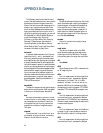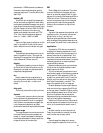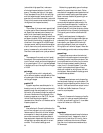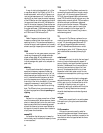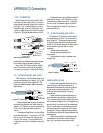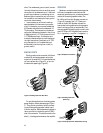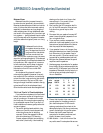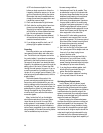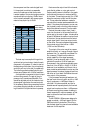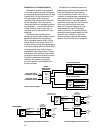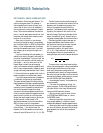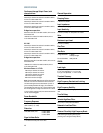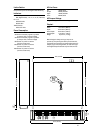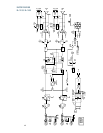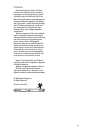
38
Biamplified and triamplified systems use
separate power amplifiers to power each indi-
vidual low-frequency and high-frequency
driver. An electronic crossover (a.k.a. active
crossover) is located between the signal source
and the power amplifier. The advantages of
this method include 1) increased headroom
available from each amplifier, since they’re am-
plifying only a portion of the entire audio
spectrum; 2) improved damping factor be-
cause the amplifier output is connected
directly to the driver; 3) improved efficiency
because there are no passive resistors to dissi-
pate heat; and 4) flexibility to choose the
optimum crossover frequency and crossover
slope for the individual drivers in the system.
Biamplified and Triamplified Systems
Most speaker systems in use today are of
the two-way or three-way variety. Cone speak-
ers are good at reproducing low and mid-range
frequencies, but not high frequencies. Like-
wise, compression drivers are good at
reproducing high frequencies, but definitely
not low frequencies. This is why two-way,
three-way and even four-way speaker systems
were developed — to improve the efficiency
of each individual driver by requiring it to
reproduce only the frequencies that it repro-
duces best.
One method of accomplishing this is
through the use of a passive crossover network
between the amplifier and the speaker(s).
Often the passive crossover is built into the
cabinet along with the various drivers. The
crossover divides the high-level speaker signal
into frequency bands, which are then directed
to the appropriate driver. There are some
drawbacks to this method, however. The pas-
sive crossover adds reactance to the load that
the amplifier sees, which can affect the damp-
ing. Power is wasted as heat across the
resistors in the crossover, reducing the
amount of amplifier power available to the
drivers themselves.
CH 1
OUT
CH 2
OUT
CH 1
IN
CH 2
IN
+
–
+
–
FR SERIES
POWER AMPLIFIER
(STEREO MODE)
HIGH FREQUENCIES
TO TWEETER
LOW FREQUENCIES
TO WOOFER
TWO-WAY SPEAKER CABINET
HIGH-LEVEL
PASSIVE
CROSSOVER
HIGH FREQUENCIES
TO TWEETER
LOW FREQUENCIES
TO WOOFER
TWO-WAY SPEAKER CABINET
HIGH-LEVEL
PASSIVE
CROSSOVER
FROM SIGNAL SOURCE
(MACKIE MIXING CONSOLE)
FROM SIGNAL SOURCE
(MACKIE MIXING CONSOLE)
CH 1
OUT
CH 2
OUT
+
–
+
–
FR SERIES
POWER AMPLIFIER
(STEREO MODE)
TO HIGH-FREQUENCY
AMPLIFIER
TO LOW-FREQUENCY
AMPLIFIER
FROM SIGNAL SOURCE
(MACKIE MIXING CONSOLE)
LOW-LEVEL
2-WAY ACTIVE
CROSSOVER
CH 1
INPUT
CH 2
INPUT
TWEE
T
WOOF
FROM SIGNAL SOURCE
(MACKIE MIXING CONSOLE)
CH 1
OUT
CH 2
OUT
+
–
+
–
FR SERIES
POWER AMPLIFIER
(STEREO MODE)
CH 1
OUT
CH 2
OUT
+
–
+
–
FR SERIES
POWER AMPLIFIER
(BRIDGE MODE)
TO HIGH-FREQUENCY
AMPLIFIER
TO MID-FREQUENCY
AMPLIFIER
LOW-LEVEL
3-WAY ACTIVE
CROSSOVER
CH 1
INPUT
CH 2
INPUT
TO LOW-FREQUENCY
AMPLIFIER
CH 1
INPUT
TWEE
T
MID
WOOF
Passive Crossover System
Triamplified System with Active CrossoverBiamplified System with Active Crossover



